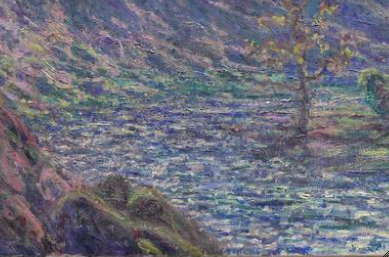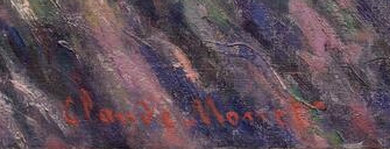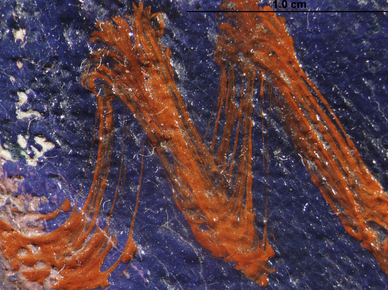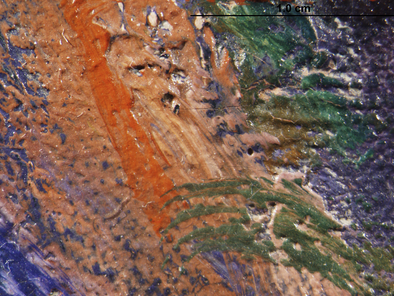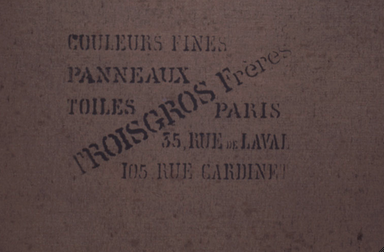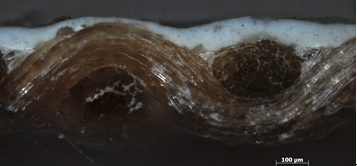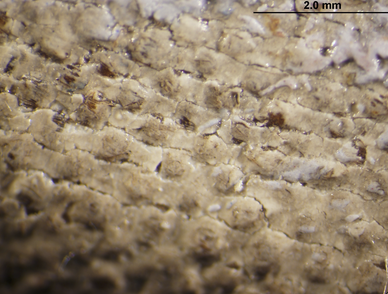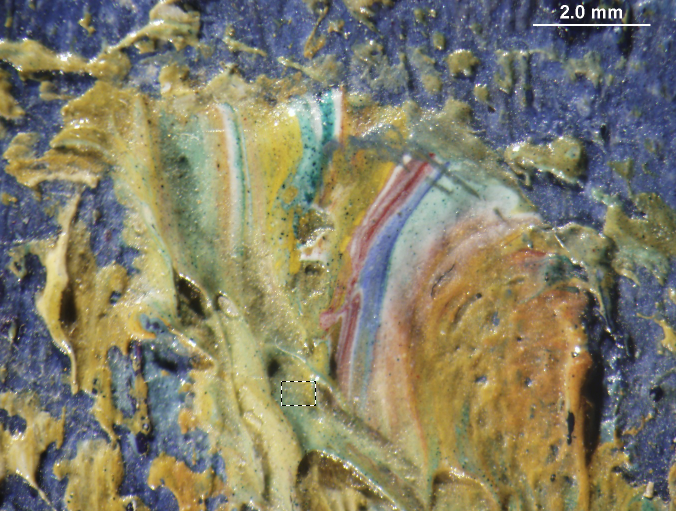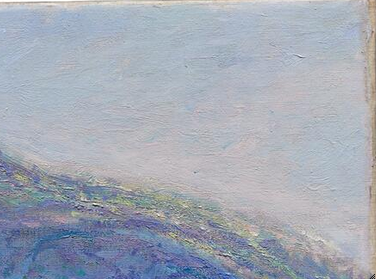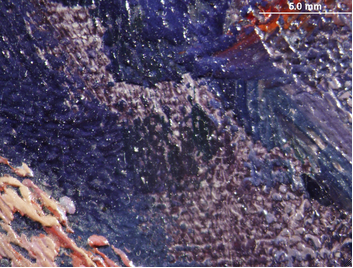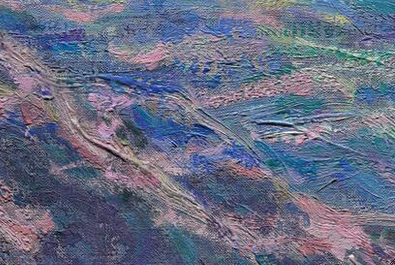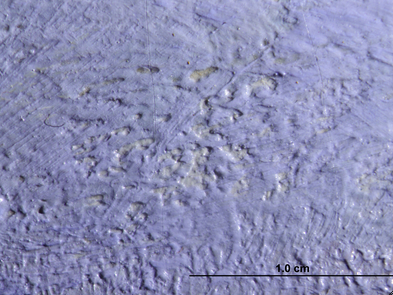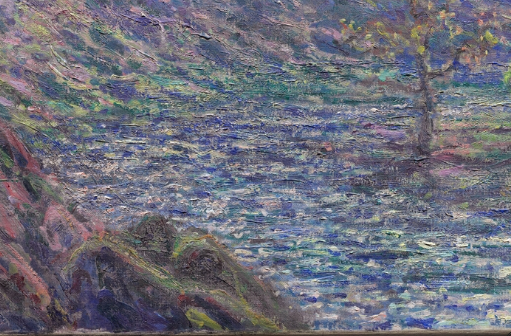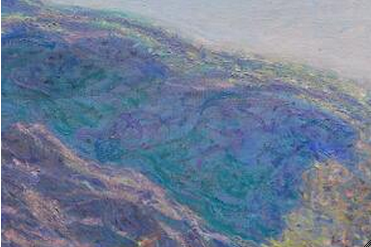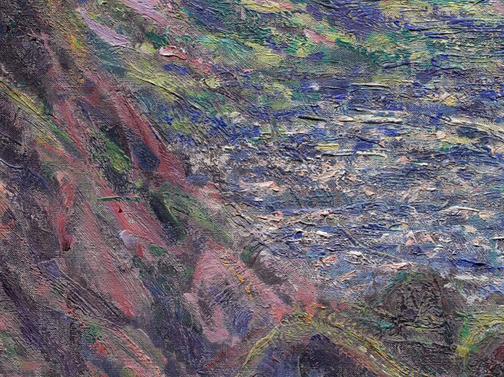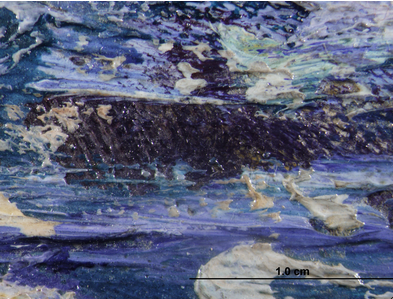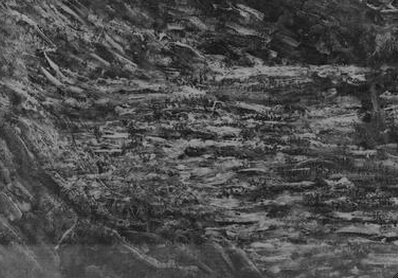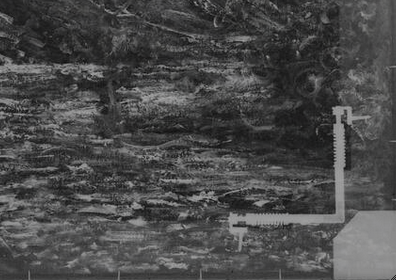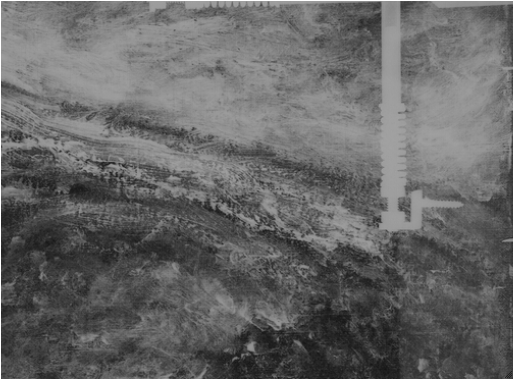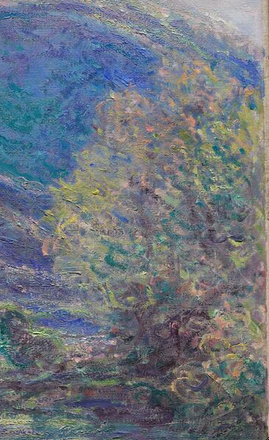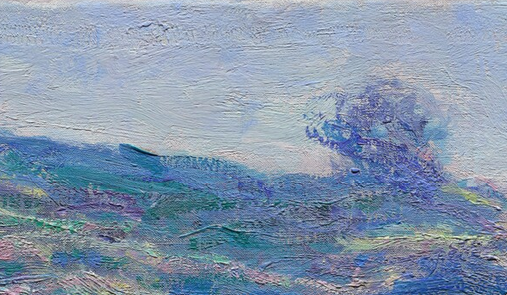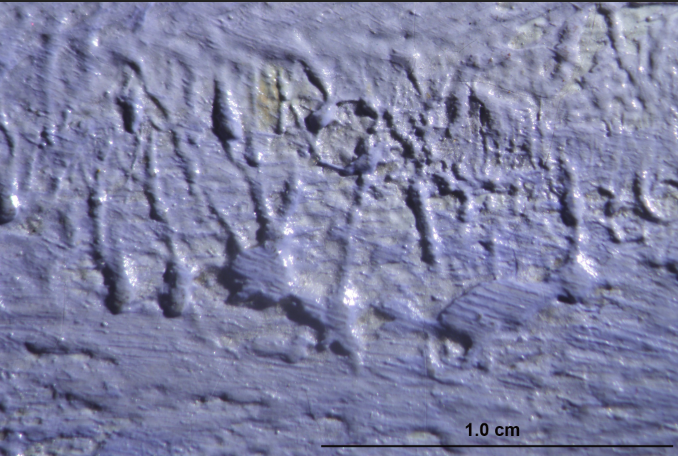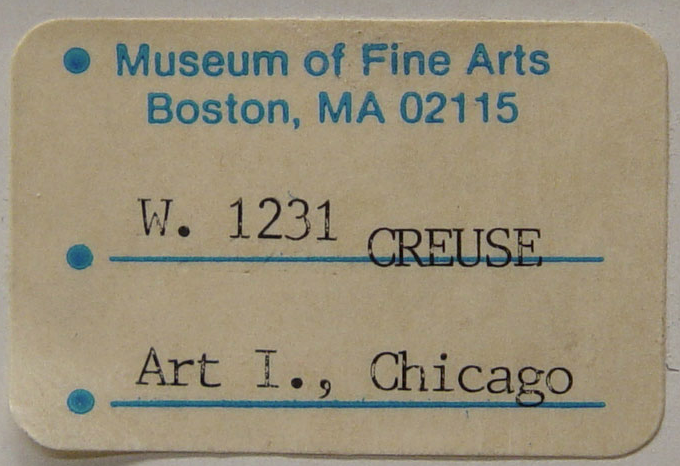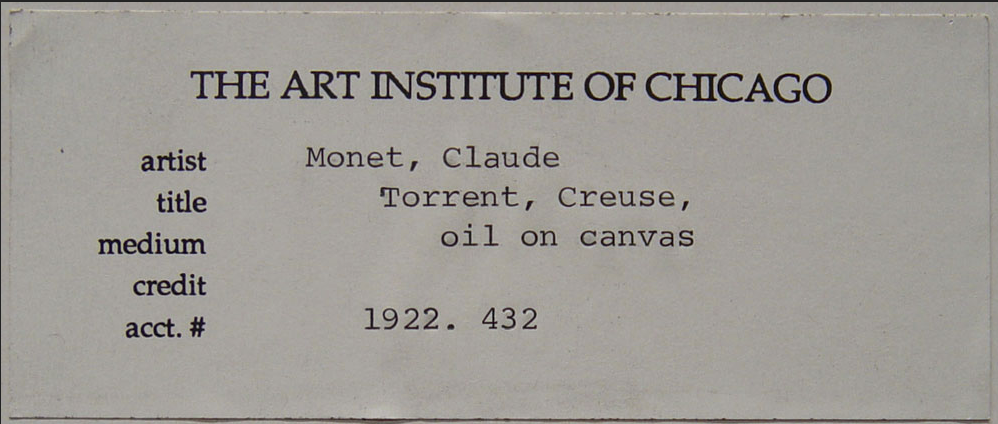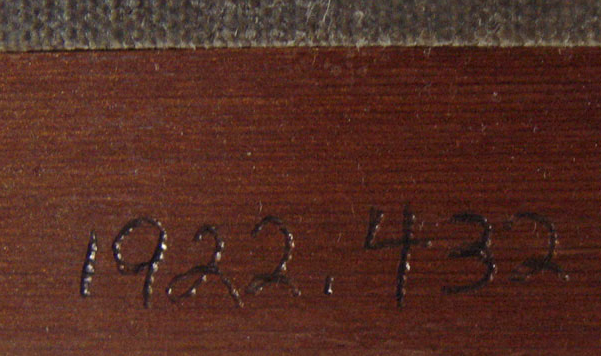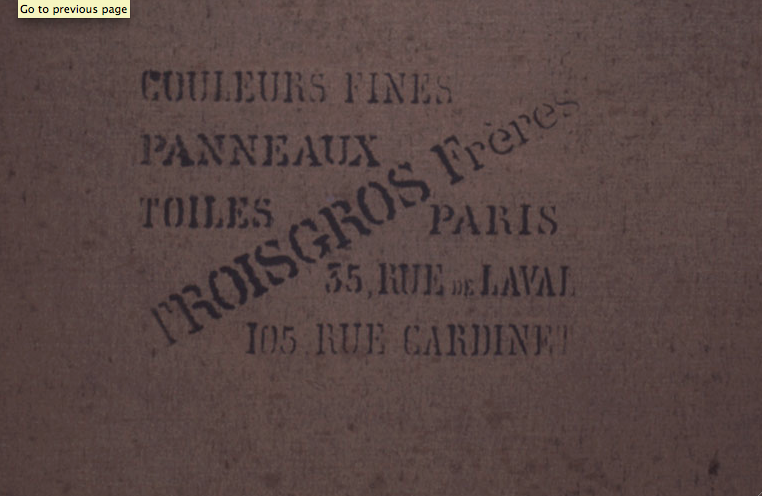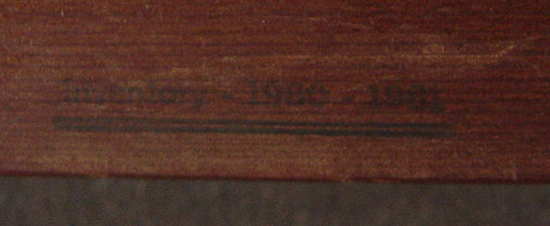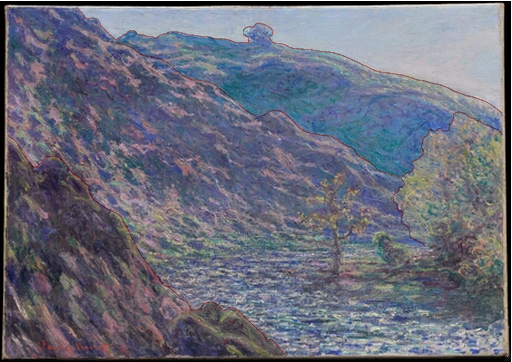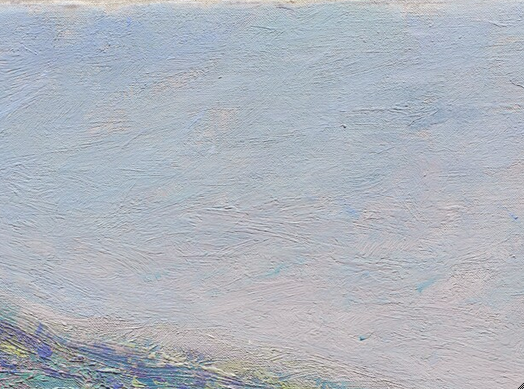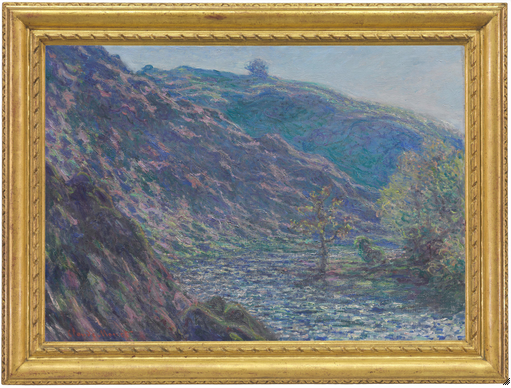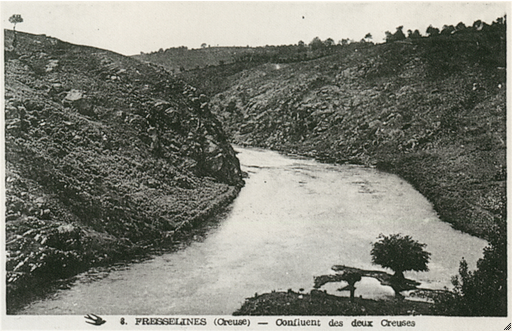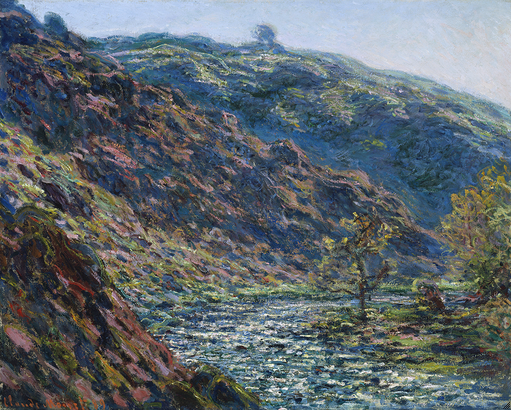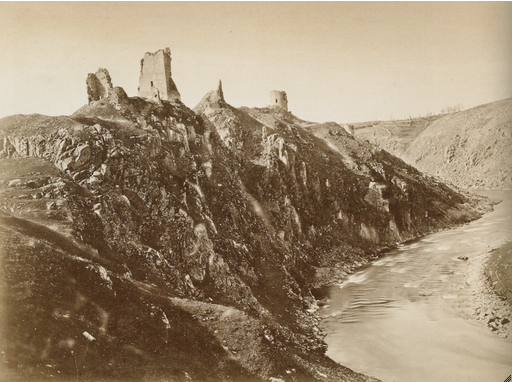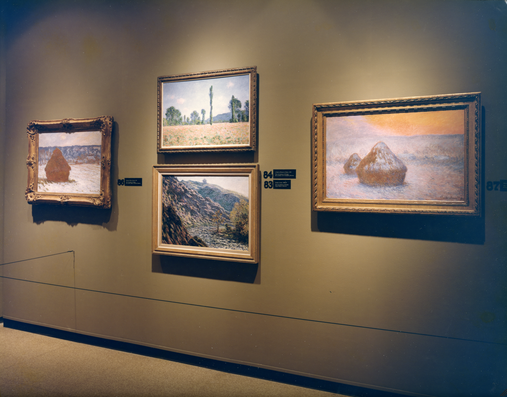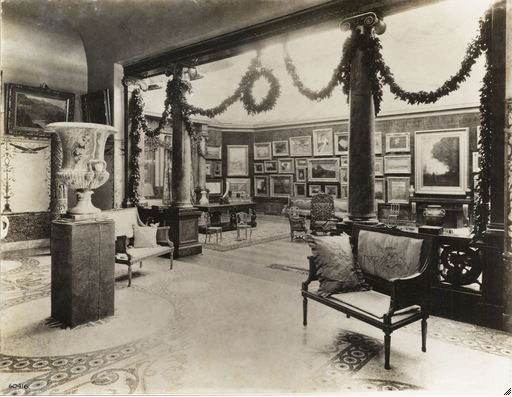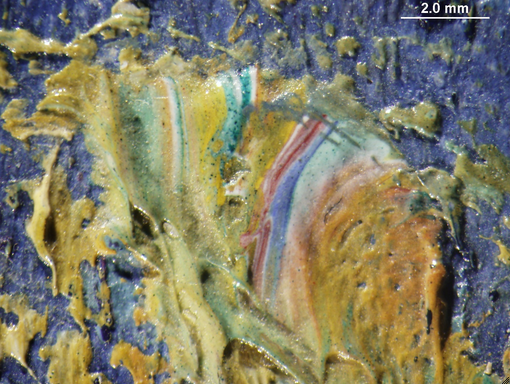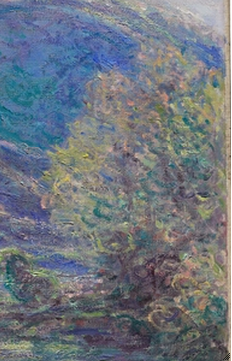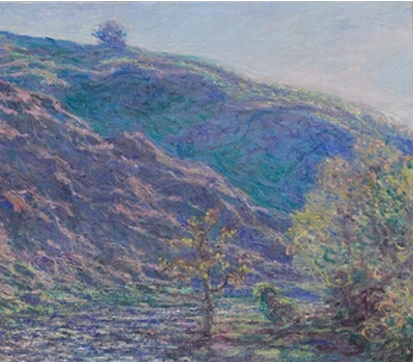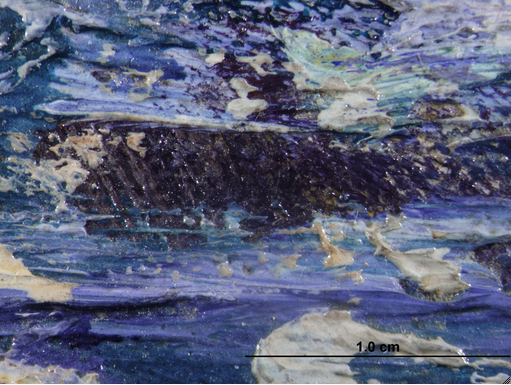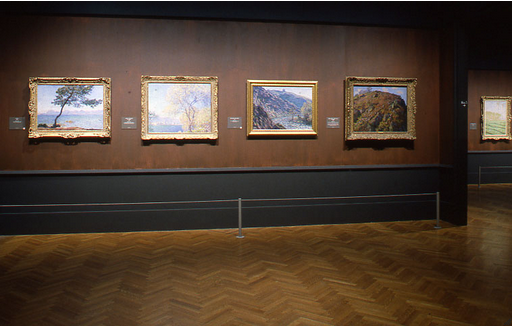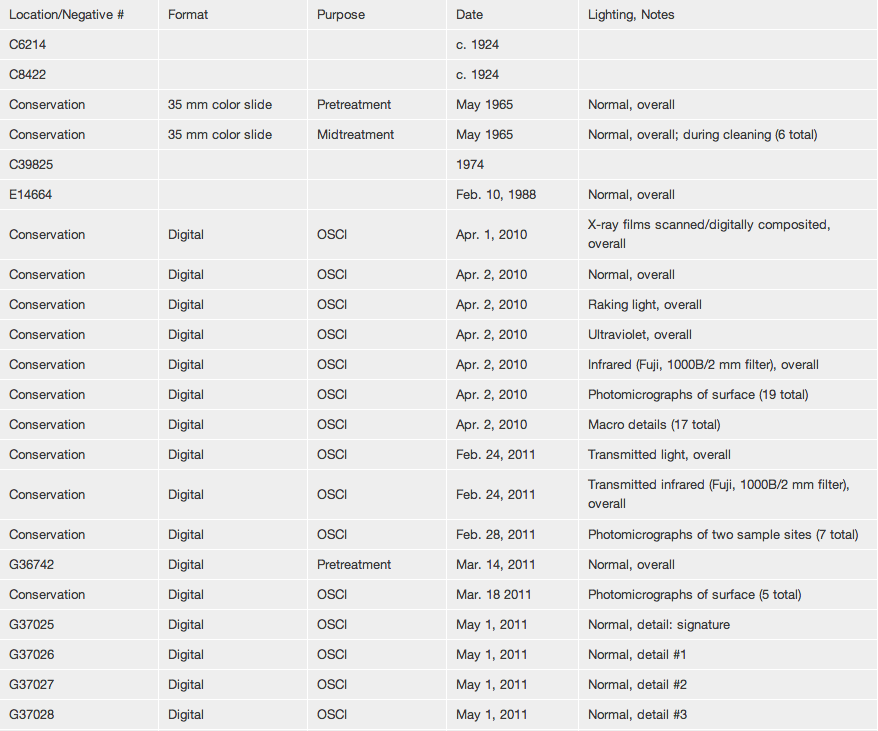Cat. 25
The Petite Creuse River
1889
Oil on canvas; 65.9 × 93.1 cm (25 15/16 × 36 5/8 in.)
Signed: Claude Monet (lower left, in orange-red paint)
The Art Institute of Chicago, Potter Palmer Collection, 1922.432
Genesis of the Creuse Campaign
Writing to his artist friend Auguste Rodin at the beginning of March 1889, Claude Monet mentioned an upcoming trip he was planning to the Creuse Valley in central France (fig. 25.1). He confided to Rodin that he anticipated that he would “do astounding things” there. He had recently been to the area for the first time, accompanying his journalist friend and future biographer Gustave Geffroy on a trip to visit the poet Maurice Rollinat at his home. Geffroy had known the poet for years and had written a long and favorable review of Rollinat’s Les névroses: Les âmes, les luxures, les refuges, les spectres, les ténèbres when it was published. The group also included Louis Mullem, editor of La justice, and the architect Frantz Jourdain. The reclusive Rollinat and his wife lived on the outskirts of the small hilltop village of Fresselines overlooking the confluence of the Petite Creuse and Grande Creuse rivers. Overwhelmed by the beauty of the region’s unspoiled terrain, Monet returned home after the weeklong excursion and immediately began preparing to return for a painting trip. Monet arrived in the region on March 7; the campaign lasted three months, much longer than Monet had estimated.
Staying at a local inn, Monet often dined with Rollinat, whose melancholy nature and mood swings may have resonated with his own. During this trip the artist endured colds, cramps, chapped hands that required gelatin-lined gloves, and lumbago, while also suffering from enormous anxiety and fatigue. On May 14, a few days before leaving Fresselines to return to Giverny, he confided to his companion, Alice Hoschedé, “You will never know what I have suffered during this campaign. . . . I am at the end of my tether.” The result of his twelve weeks of struggle with the landscape, weather conditions, and health issues was a trove of twenty-four canvases.
The art historian Paul Tucker was the first to fully recognize the significance of the Creuse campaign within the context of Monet’s career. In his groundbreaking exhibition and catalogue Monet in the ’90s: The Series Paintings, Tucker identified the Creuse River works as the artist’s first self-consciously ambitious, rigorously intense, and planned—rather than empirically determined—group of paintings to date. These river scenes also mark the artist’s first consistent attempt to control the environment, a strategy he would employ in the later series of stacks of wheat, poplar trees, mornings on the Seine, and the water lily pond at his home in Giverny.
Painting the Creuse Valley
Written while the artist worked intermittently from the end of winter through spring, Monet’s letters to Alice track the development of the motifs he had selected for these works, “morning and afternoon, sun and grey weather.” To what extent the artist may have reworked the canvases to ensure that they represented the meteorological conditions in which they were first conceived is unknown, but already within a few weeks of his return to Giverny, at least fourteen canvases were sufficiently finished to be included in the Monet-Rodin exhibition that year.
The only vertical composition in this series, Valley of the Creuse at Fresselines (fig. 25.2 [W1218]), provides a road map for Monet’s selection and framing of the Creuse paintings. Unlike other canvases in the series, which focus on narrow views of locations along the river (e.g., fig. 25.3 [W1219]), Valley of the Creuse offers a broad view of the two rivers as they converge into one. The Petite Creuse moves from the lower right diagonally across the canvas to meet the Grande Creuse, which enters the picture from center left. The conjoined river (at center) then cuts right, left, and then again right, winding off through the hills in the distance.
After setting out the topographical details of this breathtaking and dramatic canyon-like ravine, with the rivers referred to as les eaux semblantes (“twinned rivers”), Monet moved to the far side of the hill seen at the bottom left of Valley of the Creuse at Fresselines and turned his easel toward the bulbous hill formation across the river, which extends out from the center left edge of the composition. A contemporary photograph of this same view shows how precisely Monet respected the general perspective and the relationship of the hulking form to the river cutting into it (fig. 25.4). The paintings in the series, ranging from the large (e.g., The Creuse, Dark Weather [1889; Von der Heydt-Museum, Wuppertal (W1224)]) and the sunny (e.g., fig. 25.3) to the smaller sunset composition in the Musée Marmottan Monet (fig. 25.5 [W1225]), make up a significant portion of the output of the Creuse campaign (ten of the twenty-four) and were undoubtedly among the fourteen paintings that Monet claims were in progress after less than a fortnight, before the weather turned “sinister.” Trapped indoors at the village inn at Fresselines, some three kilometers away from his chosen motif, he worried that the paintings would be too lugubrious and that he might have to start over when good weather returned.
The Petite Creuse Valley
The Art Institute’s painting and two closely related canvases (fig. 25.6 [W1230] and fig. 25.7 [W1232]) all show the Petite Creuse before it merges with the Grande Creuse. For this trio, Monet moved slightly upstream, repositioning himself so he could take in the hills sloping steeply in from the left with a solitary oak tree on the other side of the river. The fuller, rounded trees, visible from a higher vantage point on the far left in the vertical composition (fig. 25.2), can be seen to the right of the scraggly oak (fig. 25.8) in the Petite Creuse paintings.
Instead of monumental mounds silhouetted against the sky, triangles of cascading strips of color suggest the rocky slopes. These “rivulets of contrasting color” indicate, in the lower right of the composition, the point at which the river bends and flows toward the confluence. Similar to the hill paintings of the Creuse Valley, each of the Petite Creuse trio shows the effects of sunlight and shadows hitting the face of a hill or cliff, seen particularly in the indentations of the natural crevices with their purple hollows.
For the Art Institute’s version of the Petite Creuse, Monet made only a few adjustments. Following his usual working method, he laid in the basic composition thinly and then built up the forms with individual strokes of paint applied in different lengths and directions (fig. 25.9). The brushstrokes were often applied wet-in-wet, which suggests that he painted quickly; in some cases a single stroke included multiple colors (e.g., fig. 25.10), indicating little or no mixing on the palette (see Technical Report). In a related sketchbook drawing (fig. 25.11 [D361]), Monet seems to have conceived the Petite Creuse canvases as compositions based on large triangular forms. In the paintings, the ridges are color coded according to the time of day, with the Art Institute’s palette being closest to Valley of the Creuse (Sunlight Effect) (fig. 25.3). In both, dark pinks and purples were used for the nearest hill; neon greens, yellows, and lavenders for the middle and sunlit hill; and a medley of blues, turquoises, and pinks for farthest. In the Art Institute’s painting, counterbalancing the long horizontal strokes used to suggest the cascading crevices of this rugged terrain are the flicks of color applied in smaller touches to suggest rippling waters (see Technical Report). Swirls of neon green seen in the tree shaped like a dinosaur and in its larger, fuller neighbor on the landmass at middle right echo patches of a similar green seen on the opposite hillside (fig. 25.12). Monet added as finishing flourishes intensely colored strokes, rendered with an extremely light touch, which skip across the canvas and enliven the surface (fig. 25.13). The result has a woven, skein-like quality with an extraordinarily high-hued palette. Even when compared to the “terrible savagery” of the Belle-Île paintings (1886; see cat. 24)—a preceding campaign with difficult terrain and unpredictable weather that Monet likened to the conditions he experienced while in the Creuse—the brushwork and palette that resulted in the vibrating surfaces seen in these Petite Creuse paintings were a new development.
The Old Oak
It is likely that Monet began the three Petite Creuse canvases before April 13, when he was forced to suspend work for three weeks because of a combination of health-related issues and bad weather. By the time Monet returned to the location in early May, springtime had arrived, and he found the landscape radically changed. The spring thaw had caused the river to rise, and the sun reflecting off the drop of the river was blindingly bright. Some trees had been cut down and some had sprouted leaves, including the oak tree just right of center in the Petite Creuse trio. Monet had laid in both this tree and its fuller companions, along with the tree at the top of the hill, early on (fig. 25.14). For Monet the oak tree, marking a bend in the Petite Creuse, played the “lead role” compositionally in the three Petite Creuse paintings.
The gnarled oak tree was essential to Monet’s emotional and aesthetic attachment to this site: not only did it impart a rhythm and pattern to the surface, it conveyed a mood. So important was the tree’s nature as he first encountered it to his concept that he determined to undo nature itself. Instead of accepting the seasons’ effects and reworking or even restarting the canvas accordingly, Monet intervened to reverse them. Hiring workers to scale ladders to defoliate the tree, Monet re-created its winter appearance.
In addition to modifying the actual oak tree, Monet made a few changes to his painted composition: giving a little more volume to the tree at right, adding a dip in the horizon line at far left (fig. 25.15), and raising the water level at the point where it meets the hill in the left foreground, which at one time extended farther into the Petite Creuse (fig. 25.15 and fig. 25.16). These compositional adjustments, along with the additional strokes of intense color added lightly to the surface (perhaps at the same time he added his signature and some additional brushstrokes, see Technical Report), suggest work done away from the motif and probably after his return to Giverny, where he edited and harmonized, rather than radically or substantially reworked the series.
The Significance of the Creuse Campaign
Apart from the physical strain Monet experienced while working in Fresselines, he was stricken by anxieties about his upcoming exhibition at Galerie Georges Petit, the opening of which was scheduled for June to coincide with the massive Exposition Universelle. For the first time in his career, Monet’s work was generously on display, and from his own choosing. He shared the show with Auguste Rodin, whose public commissions in the 1880s (notably Les bourgeois de Calais) had guaranteed the sculptor official and financial success at a time when Monet was still struggling. The Creuse canvases were created on the eve of this breakthrough exhibition, which consisted of 145 paintings by Monet paired with 36 sculptures by Rodin. The exhibition was neither chronological nor thematic; it included canvases from Monet’s painting trips at Belle-Île and Antibes from the 1880s, and fourteen Creuse paintings never previously on view and shown together for the first time as a self-contained set. These can be seen as a response to the myths springing up about him—as the artist of la France profonde, authentic France, and as the “methodical” artist who approached the landscape in a “mathematical” manner, a method as progressive as the science of his own times.
The exhibition, a critical as well as commercial success for Monet, introduced him to an international audience and, in particular, to American collectors. Critics were effusive in their praise for both artists, recognizing the historic moment of two lions of the vanguard together in one exhibition. Monet’s landscapes were especially praised in general for their truthful evocation of specific times of day and changing atmospheric conditions: “No painter, in these times, has known, better than M. Monet, how to express the infinite variety of things, to represent their changing aspects, with their mobility, their form and their color, at the hour in which they appeared, [and] in their atmosphere and light.”
Monet seems to have attached particular importance to the recently completed Creuse canvases. He hung the fourteen together as a group—this was the first time that he employed this strategy, one that he would go on to use throughout the 1890s and that indicates how much he valued them. Monet’s high regard for the series was reciprocated by critics like Paul Focher, despite their more challenging subject matter. Focher admired the “uncomparable majesty” and Octave Maus, leader of the Brussel-based avant-garde exhibition Les XX, esteemed the “extraordinary mastery” of the Creuse group.
In the Creuse Valley, factors ranging from ill heath to variable and severe weather conspired against Monet. Even though he talked about moving on to the valley of Crozant, a more popular spot for artists that was famous for picturesque ruins (fig. 25.17), Monet remained a prisoner to the Creuse Valley. Consequently after the “suffering” he had experienced while working there, and perhaps as a response to it, Monet turned his attention to subjects in close proximity to his home at Giverny, where he would be able to assert more control and pursue his aims more efficiently. Describing the lasting impact of the Creuse series, Tucker writes, “the Creuse pictures speak about certain fundamentals of art and nature in even stronger language than any previous group of paintings, fundamentals that once again would be critical to Monet’s series paintings of the next decade.”
Gloria Groom
Technical Report
Technical Summary
Claude Monet’s The Petite Creuse River was executed on a pre-primed, no. 30 landscape (paysage) standard-size linen canvas. There is a stamp from the color merchant Troisgros Frères on the back of the original canvas. There is a single, off-white ground layer. A warp-thread match was detected with seven other Monet paintings from the Art Institute’s collection: Stacks of Wheat (End of Summer) (cat. 27 [W1269], inv. 1985.1103), Stacks of Wheat (End of Day, Autumn) (cat. 28 [W1270], inv. 933.444), Stacks of Wheat (Sunset, Snow Effect) (cat. 29 [W1278], inv. 1922.431), Stack of Wheat (Thaw, Sunset) (cat. 32 [W1284], inv. 1983.166), Sandvika, Norway (cat. 34 [W1397], inv. 1961.790), Branch of the Seine near Giverny (Mist) (cat. 36 [W1475], inv. 1933.1156), and Water Lily Pond (cat. 37, [W1628], inv. 1933.441) suggesting that the fabric for these paintings came from the same bolt of material. The artist built up the composition from an initial lay-in that included both thin toning layers and long, impasted, lead white–rich strokes, which were used to block in the basic features of the landscape. The composition was worked up as a whole, using individual strokes and touches of color, which were often applied wet-on-wet but with little mixing or blending of brushwork on the canvas. A few minor adjustments were made along the edges of some of the main compositional elements, indicating slight modifications to stretches of the riverbank and the contours of some of the hills.
Multilayer Interactive Image Viewer
The multilayer interactive image viewer is designed to facilitate the viewer’s exploration and comparison of the technical images (fig. 25.18).
Signature
Signed: Claude Monet (lower left, in orange-red paint) (fig. 25.19). The signature was applied when some of the underlying paint was still wet (fig. 25.20). A final stroke of green paint from the hill passes over the bottom of the t at the end of the signature (fig. 25.21). This suggests that some final strokes were added to the painting both before and after it was signed.
Structure and Technique
Support
Canvas
Flax (commonly known as linen).
Standard format
The original dimensions were approximately 65 × 92.5 cm. This corresponds closely to a no. 30 landscape (paysage) standard-size canvas (65 × 92 cm).
Weave
Plain weave. Average thread count (standard deviation): 23.3V (0.6) × 22.4H (0.8) threads/cm. The vertical threads were determined to correspond to the warp and the horizontal threads to the weft. A warp-thread match was found with seven other Monet paintings in the Art Institute’s collection: Stacks of Wheat (End of Summer) (cat. 27 [W1269], inv. 1985.1103), Stacks of Wheat (End of Day, Autumn) (cat. 28 [W1270], inv. 933.444), Stacks of Wheat (Sunset, Snow Effect) (cat. 29 [W1278], inv. 1922.431), Stack of Wheat (Thaw, Sunset) (cat. 32 [W1284], inv. 1983.166), Sandvika, Norway (cat. 34 [W1397], inv. 1961.790), Branch of the Seine near Giverny (Mist) (cat. 36 [W1475], inv. 1933.1156), and Water Lily Pond (cat. 37 [W1628], inv. 1933.441).
Canvas characteristics
There is regular, fairly even cusping on all four edges; it is slightly more pronounced on the left and right sides.
Stretching
Current stretching: Dates to 1965 treatment (see Conservation History); copper tacks spaced approximately 8 cm apart. There is a series of small pinholes, spaced roughly 9–12 cm apart. Some are on the current foldover, but this likely would have been part of the original tacking margin. Their origin and purpose are unknown.
Original stretching: Tack holes, spaced approximately 5–8 cm apart, correspond to the cusping pattern.
Stretcher/strainer
Current stretcher: ICA spring stretcher. Depth: 2.5 cm.
Original stretcher: Discarded/not documented. Depth: Based on a second crease in the tacking margins, where it looks like excess canvas was folded over the back face of the original stretcher, the original stretcher depth was approximately 1.5 cm.
Manufacturer’s/supplier’s marks
There is a supplier’s stamp on the back of the original canvas, which was photographed before the painting was lined in 1965 (see Conservation History):
COULEURS FINES / PANNEAUX / TOILES / TROISGROS Frères / PARIS / 35, RUE DE LAVAL / 105 RUE CARDINET (fig. 25.22). The transmitted-infrared image shows that the stamp is located on the midright side of the back of the painting (fig. 25.23).
Preparatory Layers
Sizing
In UV light, evidence of a light-blue fluorescence between the canvas and the ground suggests the presence of an organic layer, possibly glue sizing (fig. 25.24).
Ground application/texture
The ground layer extends to the edges of all four tacking margins, indicating that the canvas was cut from a larger piece of primed fabric, which was probably commercially prepared. The ground consists of a single layer that ranges in thickness from approximately 10 to 90 µm, with the layer thicker in the interstices of the canvas weave and much thinner on the tops of the canvas threads in the samples analyzed (fig. 25.25).
Color
The ground is off-white (fig. 25.26). Microscopically, a few dark and possibly red particles were observed.
Materials/composition
Analysis indicates that the ground contains lead white and calcium carbonate (chalk) with traces of bone black, iron oxide, alumina, silica, and various silicates. Binder: Oil (estimated).
Compositional Planning/Underdrawing/Painted Sketch
Extent/character
No underdrawing was observed with infrared reflectography (IRR) or microscopic examination.
Paint Layer
Application/technique and artist’s revision
The main parts of the composition were worked up simultaneously, with only minor adjustments made along the borders in some places. The artist moved freely between the background and foreground, building up the composition as a whole. The initial lay-in involved the use of both thin toning layers and a few long, impasted strokes. Some time passed between this stage and the building up of the painting since the thick ridges of the underlying strokes were dry when subsequent paint was applied on top, contributing to the final surface texture of the painting (fig. 25.27). The painting was built up using individual touches of color, often applied wet-on-wet (fig. 25.28). Sometimes, multiple colors were picked up on the brush and laid down in a single stroke (fig. 25.29). The sky is the only area of the painting where there is some blending of the brushwork (fig. 25.30).
The hills were laid in using very thin applications of relatively dark color, which served as a general toning layer. The brushwork of these initial layers is not continuous, and it varies in hue from reddish-purple to brown (fig. 25.31), although the distant hill consists of fairly continuous brushwork, which makes it difficult to see the earlier paint layers. The highlighted areas of the hills were created using lead white–rich paint mixtures (pale pink, yellow, and green) lightly dragged across the surface in a network of strokes, which were often pulled through the wet blue and green paint underneath (fig. 25.32). The lighter areas of the sky and the water, on the other hand, are due to either a light-colored underpainting or areas of exposed ground layer. The sky, for example, was laid in with an underlayer off-white to pale blue in color (fig. 25.33, fig. 25.34), which remains visible in places through breaks in the brushstrokes applied on top. The water was worked up, in a network of strokes, directly over the off-white ground layer (fig. 25.35): initially long, impasted, lead white–rich strokes were laid down horizontally. These were then broken up by the short strokes and touches of more intense blue, green, and yellow paint applied on top. When the painting is viewed in transmitted light, one can see that the far side of the river is less thickly built up and that many of the light-colored areas are actually exposed ground, whereas, on the near side, the highlights are thick dashes of white or light-colored paint applied to the surface (fig. 25.36). Both the tree on the top of the hill and the one at the edge of the landmass at right were laid in early on, based on the wet-in-wet application of the earlier strokes of the trees with the adjacent areas of sky and landscape, respectively. The foliage was then built up once the areas behind were well established. Some of the final touches to the painting included the intensely colored, curving strokes applied with such a light touch that they skip across the recesses of the paint texture. This can be seen in the reddish-brown strokes at the base of the right-hand tree (fig. 25.37) and in the deep green and blue strokes used to enliven the shadowed area of the distant hill (fig. 25.38).
A few small modifications were made to the edges of some of the forms in the painting stage. Some underlying, diagonal brushstrokes at the edge of the foreground hill at left indicate that its slope was originally more continuous; that is, without the dip that occurs near the bottom and that was created by extending the water further left in that area (fig. 25.39). The rocks at the bottom of the hill seem to have extended further right into the water when this area was initially laid in. This is evidenced by the dark brownish and purplish underpainting that is visible in the water in an area that follows the contour of the rocks (fig. 25.40, fig. 25.41). Strong horizontal strokes along the distant shoreline, seen in the X-ray (fig. 25.42), suggest that the shoreline was originally placed slightly higher. Similarly, the boundary between the river and the landmass at right may also have been slightly modified. Comparison of the X-ray with the surface image suggests that the river may have originally been broader in that area (fig. 25.43). At the extreme right, it looks like the hilltop was initially painted in with a more gradual slope at the right edge. Paint from the sky was then added over the edge of the hill, creating a slightly steeper incline (fig. 25.44). Foliage on the left side of the trees at the right edge was extended further to the left, on top of the already painted hills (fig. 25.45).
A long, narrow impression, made when something was pressed against the paint while it was still wet, is visible near the top edge (fig. 25.46). This mark could be from an easel cleat or a case used for transporting the painting. It looks like some final, slightly more intense blue strokes were applied over this area of disturbed paint when it was already dry (fig. 25.47). Flattened areas of paint around the edges suggest that the work was framed when the paint was still soft (fig. 25.48).
Painting tools
Brushes, including 0.5, 1.0, and 1.5 cm width, flat ferrule (based on width and shape of brushstrokes).
Palette
Analysis indicates the presence of the following pigments: lead white, cadmium yellow, chrome yellow, vermilion, red lake, emerald green, viridian, cobalt blue, ultramarine blue, and a possible trace of bone black., UV fluorescence of pink and red strokes suggests the use of red lake throughout the landscape and in the signature. A paint sample from the dark, shadowed area of the rock, near the center of the bottom edge, shows the complex mixture of pigments that Monet used in this area (fig. 25.49).
Binding media
Oil (estimated).
Surface Finish
Varnish layer/media
The painting is currently unvarnished. The synthetic resin, applied in 1965, was removed in 2011. The painting was previously varnished in 1922 (see Conservation History).
Conservation History
An undated memo in the conservation file indicates that the painting was cleaned and varnished in 1922.
In 1965, the painting was cleaned, including removal of a “soft resin” varnish. The canvas was wax-resin lined and stretched on a new ICA spring stretcher. A spray coat of (PVA) polyvinyl acetate AYAA was applied, followed by a final spray coat of methacrylate resin L-46.
In 2011, the layers of synthetic varnish applied in 1965 and residues of natural-resin varnish from earlier treatment were removed and the painting was left unvarnished.
Condition Summary
Overall, the painting is in very good condition. The canvas is wax-resin lined and stretched taut and in plane on an ICA spring stretcher. There are two splits in the canvas (approximately 5 cm long) at the upper left foldover edge, and a tiny hole at the right side of the bottom edge. These areas are secure. There is minor abrasion to the ground and paint layers at the foldovers and in the frame rebate area. The paint layer is secure with only a couple of tiny losses near the edges. There is some slightly flattened and crushed impasto in a few places, probably the result of the lining procedure. There is some light cracking in areas of impasto and in the lead white-rich layers of the sky at upper right. A few small, localized areas of drying cracks are visible in the dark paint at lower left and lower right and associated with yellow-containing paint mixtures in the center foreground. Topped-off protrusions observed occasionally in the paint layer could be related to the presence of metal soaps (fig. 25.50). Starch-paste residues from the facing adhesive used in the lining procedure are visible over the surface, especially in the more textured areas of paint. Gold accretions from the frame are visible intermittently around the edges. The painting is currently unvarnished.
Kimberley Muir
Frame
Current frame (installed in 1995): The frame is not original to the painting. It is a reproduction of a Louis XIII convex frame, with carved leaf-tip back, plain face, and inner ribbon molding with ogee sight (Paul Mitchell Ltd., London, 1995). The frame is water gilded over red bole on gesso. The gilding is burnished throughout and toned with oil paint wash and glue size. The carved jelutong moldings are mitered and nailed. The molding, from perimeter to interior, is outer fillet with carved leaf-tip molding; cove; fillet with rocked recutting; convex face; fillet with rocked recutting; hollow; fillet with rocked recutting; torus with carved ribbon; fillet with rocked recutting; and ogee sight (fig. 25.51).
Previous frame (installed by 1975; removed in 1995): The work was previously housed in an American, mid-twentieth-century, gilded, wedge-profile frame with beaded outer edge, white cove sight, and an independent gilded liner (fig. 25.52).
Previous frame (removed by 1975): The work was previously housed in a late-nineteenth–early-twentieth-century, Louis XIV Revival, gilded, convex frame, with deeply cast plaster ornament and independent fillet liner with cove sight (fig. 25.53).
Kirk Vuillemot
Provenance
Acquired from [unknown] by Potter Palmer, Chicago.
By descent from Potter Palmer (died 1902), Chicago, to the Palmer family.
Given by the Palmer family to the Art Institute of Chicago, 1922.
Exhibition History
Art Institute of Chicago, “A Century of Progress”: Loan Exhibition of Paintings and Sculpture for 1934, June 1–Oct. 31, 1934, cat. 220.
University of Chicago, Lexington Hall, Nov. 17–Dec. 17, 1952, no cat.
Park Forest (Ill.) Art Center, Mar. 25–Apr. 22, 1956, no cat.
Art Institute of Chicago, The Paintings of Claude Monet, Apr. 1–June 15, 1957, no cat.no.
Art Institute of Chicago, Paintings by Monet, Mar. 15–May 11, 1975, cat. 83. (fig. 25.54)
Milwaukee Art Museum, 1888: Frederick Layton and His World, Apr. 8–Aug. 28, 1988, cat. 45 (ill.).
Boston, Museum of Fine Arts, Monet in the ’90s: The Series Paintings, Feb. 7–Apr. 29, 1990, cat. 8 (ill.); Art Institute of Chicago, May 19–Aug. 12, 1990; London, Royal Academy of Arts, Sept. 7–Dec. 9, 1990.
Art Institute of Chicago, Claude Monet, 1840–1926, July 22–Nov. 26, 1995, cat. 92 (ill.). (fig. 25.55)
Florence, Sala Bianca di Palazzo Pitti, Claude Monet: La poesia della luce; Sette capolavori dell’Art Institue di Chicago a Palazzo Pitti, June 2–Aug. 29, 1999, no cat. no. (ill.).
Paris, Galeries Nationales, Grand Palais, Claude Monet, 1840–1926, Sept. 22, 2010–Jan. 24, 2011, cat. 83 (ill.).
Selected References
Art Institute of Chicago, “Accessions and Loans,” Bulletin of the Art Institute of Chicago 16, 3 (May, 1922), p. 47.
Art Institute of Chicago, Handbook of Sculpture, Architecture, and Paintings, pt. 2, Paintings (Art Institute of Chicago, 1922), p. 68, cat. 836.
Art Institute of Chicago, A Guide to the Paintings in the Permanent Collection (Art Institute of Chicago, 1925), p. 147, cat. 836.
M. C., “Monets in the Art Institute,” Bulletin of the Art Institute of Chicago 19, 2 (Feb. 1925), p. 19.
Art Institute of Chicago, Catalogue of “A Century of Progress”: Exhibition of Paintings and Sculpture, 1934, ed. Daniel Catton Rich, exh. cat. (Art Institute of Chicago, 1934), p. 38, cat. 220.
Oscar Reuterswärd, Monet: En konstnärshistorik (Bonniers, 1948), p. 289.
Art Institute of Chicago, “Catalogue,” Art Institute of Chicago Quarterly 51, 2 (Apr. 1, 1957), p. 33.
Art Institute of Chicago, Paintings in the Art Institute of Chicago: A Catalogue of the Picture Collection (Art Institute of Chicago, 1961), p. 320.
Grace Seiberling, “The Evolution of an Impressionist,” in Paintings by Monet, ed. Susan Wise, exh. cat. (Art Institute of Chicago, 1975), p. 32.
Susan Wise, ed., Paintings by Monet, exh. cat. (Art Institute of Chicago, 1975), p. 140, cat. 83 (ill.).
Daniel Wildenstein, Claude Monet: Biographie et catalogue raisonné, vol. 3, Peintures, 1887–1898 (Bibliothèque des Arts, 1979), pp. 124; 125, cat. 1231 (ill.); 248, letters 975 and 976.
Robert Gordon and Andrew Forge, Monet (Abrams, 1983), pp. 126–27 (ill.), 291.
Charles F. Stuckey, ed., Monet: A Retrospective (Hugh Lauter Levin, 1985), pp. 138; 187, pl. 75.
Milwaukee Art Museum, 1888: Frederick Layton and His World, exh. cat. (Milwaukee Art Museum, 1988), pp. 124–25, cat. 45 (ill.).
Richard Kendall, ed., Monet by Himself: Paintings, Drawings, Pastels, Letters, trans. Bridget Strevens Romer (Macdonald Orbis, 1989), pp. 169 (ill.), 319.
Paul Hayes Tucker, Monet in the ’90s: The Series Paintings, exh. cat. (Museum of Fine Arts, Boston/Yale University Press, 1989), pp. 47; 48, pl. 11; 50; 55; 295, cat. 8.
Martha Kapos, ed., The Impressionists: A Retrospective (Hugh Lauter Levin/Macmillan, 1991), p. 333, pl. 105.
Steven Z. Levine, Monet, Narcissus, and Self-Reflection: The Modernist Myth of the Self (University of Chicago Press, 1994), pp. 103, 114.
Marianne Alphant, Claude Monet: Une vie dans le paysage (Hazan, 1993), p. 461.
Andrew Forge, Monet, Artists in Focus (Art Institute of Chicago, 1995), pp. 39; 41 (detail); 42–43; 84, pl. 13.
John Russell Taylor, Claude Monet: Impressions of France, from Le Havre to Giverny (Collins & Brown, 1995), pp. 7 (ill.), 101, 156.
Charles F. Stuckey, with the assistance of Sophia Shaw, Claude Monet, 1840–1926, exh. cat. (Art Institute of Chicago/Thames & Hudson, 1995), p. 113, cat. 92 (ill.).
Daniel Wildenstein, Monet: Catalogue raisonné/Werkverzeichnis, vol. 3, Nos. 969–1595 (Taschen/Wildenstein Institute, 1996), pp. 469–70, cat. 1231 (ill.).
Genevieve Morgan, ed., Monet: The Artist Speaks (Collins, 1996), pp. 55 (ill.), 95.
Carla Rachman, Monet (Phaidon, 1997), pp. 202–03, fig. 133; 204.
Art Institute of Chicago, Impressionism and Post-Impressionism in the Art Institute of Chicago, selected by James N. Wood (Art Institute of Chicago/Hudson Hills, 2000), p. 130 (ill.).
Art Institute of Chicago, Treasures from the Art Institute of Chicago, selected by James N. Wood, commentaries by Debra N. Mancoff (Art Institute of Chicago/Hudson Hills, 2000), p. 110 (ill.).
Simonella Condemi and Andrew Forge, Claude Monet: La poesia della luce; Sette capolavori dell’Art Institute di Chicago a Palazzo Pitti, exh. cat. (Giunti Gruppo, 1999), pp. 30–31 (ill.).
Vivian Russell, Monet’s Landscapes (Frances Lincoln, 2000), pp. 96 (ill.), 160.
Eric M. Zafran, “Monet in America,” in Wildenstein and Co., Claude Monet (1840–1926): A Tribute to Daniel Wildenstein and Katia Granoff, exh. cat. (Wildenstein, 2007), p. 143, fig. 62a.
Gerhard Finckh, “Faszination Monet,” in Claude Monet, ed. Gerhard Finckh, exh. cat. (Von der Heydt-Museum, 2009), p. 23 (ill.).
Richard R. Brettell, Paul Hayes Tucker, and Natalie H. Lee, The Robert Lehman Collection, Nineteenth- and Twentieth-Century Paintings, vol. 3 (Metropolitan Museum of Art, New York/Princeton University Press, 2009), p. 221, fig. 5.
Gloria Groom and Douglas Druick, with the assistance of Dorota Chudzicka and Jill Shaw, The Age of French Impressionism: Masterpieces from the Art Institute of Chicago (Art Institute of Chicago/Yale University Press, 2010; reprinted 2013), p. 121, cat. 60 (ill.).
John House, “Le sujet chez Monet,” in Réunion des Musées Nationaux, Claude Monet, 1840–1926, exh. cat. (Réunion des Musées Nationaux/Musée d’Orsay, 2010), p. 25.
Réunion des Musées Nationaux, Claude Monet, 1840–1926, exh. cat. (Réunion des Musées Nationaux/Musée d’Orsay, 2010), p. 217, cat. 83 (ill.).
Richard Thomson, “Un naturalism d’émotivité, 1881–1891,” in Réunion des Musées Nationaux, Claude Monet, 1840–1926, exh. cat. (Réunion des Musées Nationaux/Musée d’Orsay, 2010), pp. 32–33 (detail).
Richard Thomson, “À Belle-Île 1886; Dans la Creuse, 1889,” in Réunion des Musées Nationaux, Claude Monet, 1840–1926, exh. cat. (Réunion des Musées Nationaux/Musée d’Orsay, 2010), pp. 210, 211.
Pierre Buvat, Sur les pas de Claude Monet à Fresselines, février-mai 1889: “De la perce-neige à l’églantine” (Nouvelle Picarle, 2011), (ill.).
Christophe Rameix, Impressionnisme et postimpressionnisme dans la Vallée de la Creuse: The Crozant School, trans. Alain Decotigny (Christian Pirot/La Simarre, 2012), pp. 49 (ill.), 142.
Other Documentation
Labels and Inscriptions
Undated
Label
Location: stretcher
Method: printed label with handwritten script and green ink inventory stamp
Content: THE ART INSTITUTE OF CHICAGO / CHICAGO ILLINOIS 60603, U.S.A. / To Monet, Claude / Torrent, Creuse / 1922.432
Stamp: Inventory – 1980 – 1981 (fig. 25.56)
Label
Location: backing board
Method: printed label with typewritten script
Content: THE ART INSTITUTE OF CHICAGO / artist Monet, Claude / title Torrent, Creuse, / medium oil on canvas / credit / acct.# 1922.432 (fig. 25.57)
Number
Location: stretcher
Method: handwritten script
Content: 1922.432 (fig. 25.58)
Pre-1980
Stamp
Location: canvas
Method: stamp
Content: COULEURS FINES / PANNEAUX / TOILES / TROISGROS Frères / PARIS / 35, RUE DE LAVAL / 105 RUE CARDINET (fig. 25.59).
Label
Location: pre-1965-treatment stretcher (discarded); transcription in conservation file
Method: not documented
Content: Maple & Co. (Paris) Ltd. – 5 Rue Boudreau – Paris / Mr. Potter Palmer Executor and Trustee of his Mother Mrs. Potter Palmer deceased / The Art Institute of Chicago (fig. 25.60)
Post-1980
Stamp
Location: stretcher
Method: green ink stamp
Content: Inventory – 1980 – 1981 (fig. 25.61)
Label
Location: backing board
Method: printed label with typewritten script
Content: Museum of Fine Arts / Boston, MA 02115 / W. 1231 CREUSE / Art I., Chicago (fig. 25.62)
Label
Location: backing board
Method: printed label
Content: Milwaukee Art Museum / 1888: FREDERICK LAYTON AND HIS WORLD / April 7–August 28, 1988 / Claude Monet / Stream, Creuse 1888–89 / oil on canvas / The Art Institute of Chicago, / Potter Palmer Collection / At the War Memorial 750 North Lincoln Memorial Drive Milwaukee, Wisconsin 53202 (fig. 25.63)
Label
Location: backing board
Method: printed label
Content: MONET IN THE ’90s: / THE SERIES PAINTINGS / Museum of Fine Arts, Boston / Feb 7–Apr 29, 1990 / Art Institute of Chicago / May 19–Aug 12, 1990 / Royal Academy, London / Sep 7–Dec 9, 1990 / CAT#: 08 W: 1231 / TITLE: The Petite Creuse / LENDER: The Art Institute of Chicago (fig. 25.64)
Label
Location: backing board
Method: printed label
Content: The Art Institute of Chicago / “Claude Monet: 1840–1926” / July 14, 1995–November 26, 1995 / Catalog: 92 / The Petite Creuse River / Le Viel arbre au confluent / The Art Institute of Chicago, Potter Palmer Collection / (1922.432) (fig. 25.65)
Label
Location: backing board
Method: printed label
Content: rmn [logo] / Claude Monet 1840–1926 / Galeries nationales, Grand Palais / 22/09/2010–24/01/2011 / 87 / Chicago / The Art Institute of Chicago / Le Vieil Arbre au confluent / The Old Tree at the Confluence / inv. 1922-432 / huile sur toil (fig. 25.66)
Examination and Analysis Techniques
X-radiography
Westinghouse X-ray unit, films scanned on Epson Expressions 10000XL flatbed scanner. Scans digitally composited by Robert G. Erdmann, University of Arizona.
Infrared Reflectography
Fujifilm S5 Pro with X-Nite1000B/2 mm filter (1.0–1.1 µm); Inframetrics Infracam (1.5–1.73 µm filter).
Transmitted Infrared
Fujifilm S5 Pro with X-Nite1000B/2 mm filter (1.0–1.1 µm).
Visible Light
Natural-light, raking-light, and transmitted-light overalls and macrophotography: Fujifilm S5 Pro with X-NiteCC1 filter.
Ultraviolet Light
Fujifilm S5 Pro with X-NiteCC1 filter and Kodak Wratten 2E filter.
High-Resolution Visible Light (and Ultraviolet)
Sinar P3 camera with Sinarback eVolution 75 H (B+W 486 UV/IR cut MRC filter).
Microscopy and Photomicrographs
Sample and cross-sectional analysis using a Zeiss Axioplan 2 research microscope equipped with reflected light/UV fluorescence and a Zeiss AxioCam MRc5 digital camera. Types of illumination used: darkfield, differential interference contrast (DIC), and UV. In situ photomicrographs with a Wild Heerbrugg M7A StereoZoom microscope fitted with an Olympus DP71 microscope digital camera.
X-ray Fluorescence Spectroscopy (XRF)
Several spots on the painting were analyzed in situ with a Bruker/Keymaster TRACeR III-V with rhodium tube.
Polarized Light Microscopy (PLM)
Zeiss Universal research microscope.
Scanning Electron Microscopy/Energy-Dispersive X-ray Spectroscopy (SEM/EDX)
Cross sections were analyzed after carbon coating with a Hitachi S-3400N-IIVP-SEM with an Oxford EDS and a Hitachi solid-state BSE detector. Analysis was performed at the Northwestern University Atomic and Nanoscale Characterization Experimental Center (NUANCE), Electron Probe Instrumentation Center (EPIC) facility.
Automated Thread Counting
Thread count and weave information were determined by Thread Count Automation Project software.
Image Registration Software
Overlay images registered using a novel image-based algorithm developed by Damon M. Conover (GW), Dr. John K. Delaney (GW, NGA), and Murray H. Loew (GW) of the George Washington University’s School of Engineering and Applied Science and the National Gallery of Art, Washington, D.C.
Image Inventory
The image inventory compiles records of all known images of the artwork on file in the Conservation Department, the Imaging Department, and the Department of Medieval to Modern European Painting and Sculpture at the Art Institute of Chicago (fig. 25.67).
